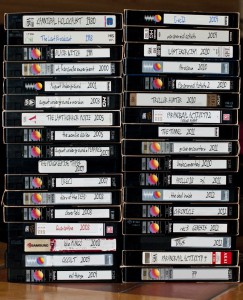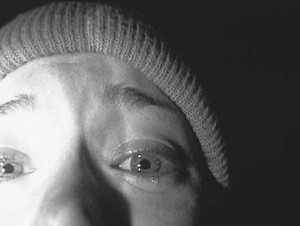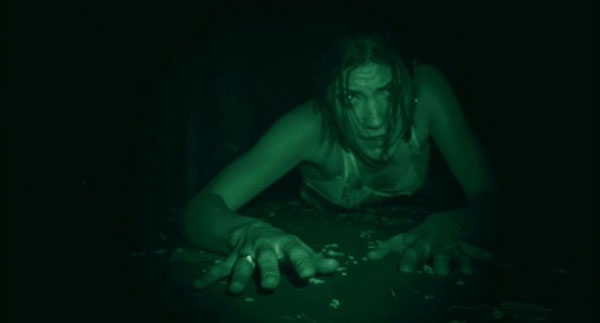 Found Footage. I love it when a term contains the conceit, just because, by accepting the term, you’ve already bought into the trick: this movie you’re watching, it’s an artifact. Which of course means that it’s real. And if a horror film can have you convinced of that before even watching—it’s a feat. Most horror on the screen strives for that. Found footage horror starts there. The analogue in fiction are those shoebox novels, that pretend to be documents and forms and snapshots recovered by a single editor and shaped very little—just a bunch of papers in a shoebox. Never mind that they’re all made-up. The fun is going into it knowing they are, and then doubt slowly creeping up on you. Film works a little differently, though. We’re not as conditioned to maintain a defensive level of interpretation between us and the text. Just because of the immediacy, I suspect. And because we think we can trust our eyes. Found footage exploits this. At the same time, everybody’s fairly tired of it, yes? Yet found footage, it just keeps on keeping on, never mind the audience’s resistance. Why? Really, I think the first is nearly always budget: you can conceivably shoot a found-footage horror movie for not very much at all. So it looks unprofessional? Of course it does. These are victims of horror, not moviemakers. And of course tied in with shooting on the cheap is pulling a Blair Witch Project at the box office, getting dollars and dollars back for every penny invested.
Found Footage. I love it when a term contains the conceit, just because, by accepting the term, you’ve already bought into the trick: this movie you’re watching, it’s an artifact. Which of course means that it’s real. And if a horror film can have you convinced of that before even watching—it’s a feat. Most horror on the screen strives for that. Found footage horror starts there. The analogue in fiction are those shoebox novels, that pretend to be documents and forms and snapshots recovered by a single editor and shaped very little—just a bunch of papers in a shoebox. Never mind that they’re all made-up. The fun is going into it knowing they are, and then doubt slowly creeping up on you. Film works a little differently, though. We’re not as conditioned to maintain a defensive level of interpretation between us and the text. Just because of the immediacy, I suspect. And because we think we can trust our eyes. Found footage exploits this. At the same time, everybody’s fairly tired of it, yes? Yet found footage, it just keeps on keeping on, never mind the audience’s resistance. Why? Really, I think the first is nearly always budget: you can conceivably shoot a found-footage horror movie for not very much at all. So it looks unprofessional? Of course it does. These are victims of horror, not moviemakers. And of course tied in with shooting on the cheap is pulling a Blair Witch Project at the box office, getting dollars and dollars back for every penny invested.  Except, ever since Blair Witch Project, there hasn’t really been a Blair Witch Project, has there? I’d guess the most successful (both in quality and in returns) found-footage horror since Blair Witch has been either Cloverfield or the Paranormal Activity franchise, with [Rec]/Quarantine coming on strong and fun. And there’s been some regrettable found footage as well. Silent House, say. Which I honestly thought might be the death-blow for found footage in horror, as it used all the tricks and trappings of found footage, but finally only as a device to trick the audience. It was bold, no doubt, but in erasing the trust necessary for us to watch this as real, it only served to highlight the form’s built-in weakness: that all these these ‘unstaged lines’ and ‘not-meticulously-composed shots’ are actually highly staged, and composition is always concern. It was an odd choice, to undermine the very non-fiction veneer that gives the form legs. And to do that with no irony. However, Silent House was no nail in the coffin of found footage, I suspect. Just because, say, I just rented another one, Skew. And, while this isn’t a Skew review, let me just say that it’s a horror movie that gives me hope for found footage. And I think it’s successful, compelling, actually-scary found-footage because it’s aware of the bells every found footage needs to hit—writer/director Sevé Sanchez is fully maximizing the form. He’s using the in-movie camera (the one ‘making’ the found footage) to hide identities; to introduce omissions; to cast suspicion; to align us with a particular point-of-view; and, finally, as an artifact within the ‘artifact,’ to refer back to, for confirmation, just as we are, by watching. It’s very well-done, I’m saying. Very competent. And, yes, I think there’s going to be more, and more, and more. I mean, the history of found footage, I’d say its roots are deep in horror. You could probably draw lines of influence all the way back to Peeping Tom, even, if you squinted just right, but I’d be quicker to align it with the slasher-cam we were introduced to in the opening sequence of Halloween, say (though of course Jaws had already used it—Black Christmas too?—and it was already a giallo staple by then). Except, in those cases, it’s the killer who had this fascination with cameras. Now it’s the victims. It’s these super-annoying Micah-types—there’s one just as annoying in Skew, don’t worry—who can’t seem to put the camera down. Or else the movie has to do some serious contortions in order to keep the device/conceit alive’ to step outside horror, take a look at Chronicle, say, where the character telekinetically hovers a camera over every shot. Or, to come back to horror, check out any of the Paranormal Activity installments after the first (security cameras, Skype, etc). So, yes, Skew, it does owe something to little-kid Michael Myers, but it owes just as much to Omen, I’d say, or The Ring, each of which manage to successfully haunt faces in photographs (which is nothing new in horror), such that you can pretty well creep yourself out, looking through your next photo album. As for the future of found footage, though, no, I don’t think it’s going to get any less shaky, sorry. Unless these victims start wearing Panaglide harnesses or Jello shoes or something, expect to wish yet again that you’d taken a motion-sickness tablet or two. Alas, I know. But, yes, I do expect complete movies of found footage to start waning, some. I expect found footage to go back to being more of a device, one of many any director has. Like in End of Watch, say, where sometimes we’re taken into ‘found footage’ for the extreme first-person, but, when it would require the story to betray itself in order for a camera to be present, the found footage fades. Or use it like Wes Craven does in the fourth Scream: to limit our field-of-view, ratchet the tension up higher and higher. One of the main reasons it’ll stay around, though, in horror and elsewhere, is because its presence introduces some instability to the narrative. Like with Blair Witch, it’s only the footage that needs to survive, now, not these characters. Found footage even kind of promises that everybody’s not making it through. In horror, anyway, that’s always a good promise, not the least because it sets us up to be truly surprised when some final girl rises, overcomes. Meaning, yes, I’m waiting for found footage to be done well in the slasher (but: Jason?), and without helmet cams, and I’m waiting for the camera to be built into the story itself, the way the bus was built into Speed, but still maintain its essential personal-ness, keep that potential for terror, like in Lake Mungo, but with a Wiksboro Incident kind of unsettling end to things. Tall order, I know. But I can dream. Of scary things. And who knows, maybe this Loss of Life will fit the order, take over the world. And, for a list of found footage in horror, this is pretty comprehensive. I mean, it’s even got Man Bites Dog and The Last Horror Movie, which most lists neglect (and, to my great embarrassment, I’ve yet to hit Grave Encounters). Anyway, just thinking about all this because, you guessed it, I’m kind of thinking of doing a found footage-ey novella or something. I want to figure out the form’s limits, and its potentials, and, talking about stuff and watching it’s good and great, of course, but doing’s the only real way to learn, I think. And I might just need to learn.
Except, ever since Blair Witch Project, there hasn’t really been a Blair Witch Project, has there? I’d guess the most successful (both in quality and in returns) found-footage horror since Blair Witch has been either Cloverfield or the Paranormal Activity franchise, with [Rec]/Quarantine coming on strong and fun. And there’s been some regrettable found footage as well. Silent House, say. Which I honestly thought might be the death-blow for found footage in horror, as it used all the tricks and trappings of found footage, but finally only as a device to trick the audience. It was bold, no doubt, but in erasing the trust necessary for us to watch this as real, it only served to highlight the form’s built-in weakness: that all these these ‘unstaged lines’ and ‘not-meticulously-composed shots’ are actually highly staged, and composition is always concern. It was an odd choice, to undermine the very non-fiction veneer that gives the form legs. And to do that with no irony. However, Silent House was no nail in the coffin of found footage, I suspect. Just because, say, I just rented another one, Skew. And, while this isn’t a Skew review, let me just say that it’s a horror movie that gives me hope for found footage. And I think it’s successful, compelling, actually-scary found-footage because it’s aware of the bells every found footage needs to hit—writer/director Sevé Sanchez is fully maximizing the form. He’s using the in-movie camera (the one ‘making’ the found footage) to hide identities; to introduce omissions; to cast suspicion; to align us with a particular point-of-view; and, finally, as an artifact within the ‘artifact,’ to refer back to, for confirmation, just as we are, by watching. It’s very well-done, I’m saying. Very competent. And, yes, I think there’s going to be more, and more, and more. I mean, the history of found footage, I’d say its roots are deep in horror. You could probably draw lines of influence all the way back to Peeping Tom, even, if you squinted just right, but I’d be quicker to align it with the slasher-cam we were introduced to in the opening sequence of Halloween, say (though of course Jaws had already used it—Black Christmas too?—and it was already a giallo staple by then). Except, in those cases, it’s the killer who had this fascination with cameras. Now it’s the victims. It’s these super-annoying Micah-types—there’s one just as annoying in Skew, don’t worry—who can’t seem to put the camera down. Or else the movie has to do some serious contortions in order to keep the device/conceit alive’ to step outside horror, take a look at Chronicle, say, where the character telekinetically hovers a camera over every shot. Or, to come back to horror, check out any of the Paranormal Activity installments after the first (security cameras, Skype, etc). So, yes, Skew, it does owe something to little-kid Michael Myers, but it owes just as much to Omen, I’d say, or The Ring, each of which manage to successfully haunt faces in photographs (which is nothing new in horror), such that you can pretty well creep yourself out, looking through your next photo album. As for the future of found footage, though, no, I don’t think it’s going to get any less shaky, sorry. Unless these victims start wearing Panaglide harnesses or Jello shoes or something, expect to wish yet again that you’d taken a motion-sickness tablet or two. Alas, I know. But, yes, I do expect complete movies of found footage to start waning, some. I expect found footage to go back to being more of a device, one of many any director has. Like in End of Watch, say, where sometimes we’re taken into ‘found footage’ for the extreme first-person, but, when it would require the story to betray itself in order for a camera to be present, the found footage fades. Or use it like Wes Craven does in the fourth Scream: to limit our field-of-view, ratchet the tension up higher and higher. One of the main reasons it’ll stay around, though, in horror and elsewhere, is because its presence introduces some instability to the narrative. Like with Blair Witch, it’s only the footage that needs to survive, now, not these characters. Found footage even kind of promises that everybody’s not making it through. In horror, anyway, that’s always a good promise, not the least because it sets us up to be truly surprised when some final girl rises, overcomes. Meaning, yes, I’m waiting for found footage to be done well in the slasher (but: Jason?), and without helmet cams, and I’m waiting for the camera to be built into the story itself, the way the bus was built into Speed, but still maintain its essential personal-ness, keep that potential for terror, like in Lake Mungo, but with a Wiksboro Incident kind of unsettling end to things. Tall order, I know. But I can dream. Of scary things. And who knows, maybe this Loss of Life will fit the order, take over the world. And, for a list of found footage in horror, this is pretty comprehensive. I mean, it’s even got Man Bites Dog and The Last Horror Movie, which most lists neglect (and, to my great embarrassment, I’ve yet to hit Grave Encounters). Anyway, just thinking about all this because, you guessed it, I’m kind of thinking of doing a found footage-ey novella or something. I want to figure out the form’s limits, and its potentials, and, talking about stuff and watching it’s good and great, of course, but doing’s the only real way to learn, I think. And I might just need to learn.  (and, yeah, I guess you could argue that Demon Theory’s found footage, but I completely didn’t have that even remotely in mind in 1999, though I guess I did see Blair Witch while writing it. And what creeped me out there, aside from the film, was all the babies crying at the midnight premiere)
(and, yeah, I guess you could argue that Demon Theory’s found footage, but I completely didn’t have that even remotely in mind in 1999, though I guess I did see Blair Witch while writing it. And what creeped me out there, aside from the film, was all the babies crying at the midnight premiere)





I just watched The Bay last night, which used found footage to create what’s one of the most utterly believable (and as a result, totally unnerving) horror movies I’ve ever seen.
wow, hadn’t even heard of that one. thanks.